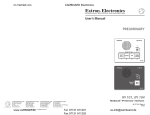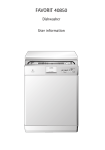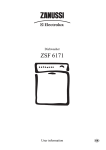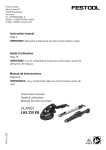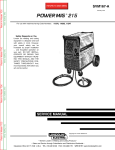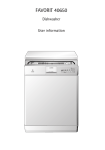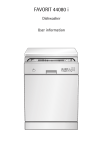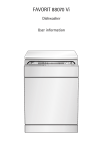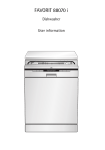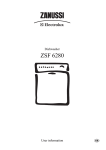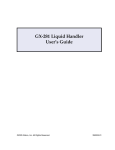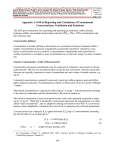Download Electrolux ESL 6251 User's Manual
Transcript
D i s h w a s h e r User information ESL 6251 822 612 669-00-300905-03 g Dear Customer, Please read these user instructions carefully and keep them to refer to later. Please pass the user instructions on to any future owner of the appliance. The following symbols are used in the text: 1 Safety instructions Warning! Notes that concern your personal safety. Important! Notes that show how to avoid damage to the appliance. 3 Useful tips and hints 2 Environmental information 2 Contents Operating Instructions . . . . . . . . . . . . . . . . . . . . . . . . . . . . . . . . . . . . . . . . . . . . . . . . . . . . . . . . . . . . . 4 Safety . . . . . . . . . . . . . . . . . . . . . . . . . . . . . . . . . . . . . . . . . . . . . . . . . . . . . . . . . . . . . . . . . . . . . . . . . . . . . . . 4 Diagram of Appliance . . . . . . . . . . . . . . . . . . . . . . . . . . . . . . . . . . . . . . . . . . . . . . . . . . . . . . . . . . . . . . . . . . 5 Control Panel. . . . . . . . . . . . . . . . . . . . . . . . . . . . . . . . . . . . . . . . . . . . . . . . . . . . . . . . . . . . . . . . . . . . . . . . . 5 Prior to Using for the First Time . . . . . . . . . . . . . . . . . . . . . . . . . . . . . . . . . . . . . . . . . . . . . . . . . . . . . . . . . Setting the Water Softener . . . . . . . . . . . . . . . . . . . . . . . . . . . . . . . . . . . . . . . . . . . . . . . . . . . . . . . . . . . . . . . Adding dishwasher Salt . . . . . . . . . . . . . . . . . . . . . . . . . . . . . . . . . . . . . . . . . . . . . . . . . . . . . . . . . . . . . . . . . Filling Up with Rinse Aid . . . . . . . . . . . . . . . . . . . . . . . . . . . . . . . . . . . . . . . . . . . . . . . . . . . . . . . . . . . . . . . . . Activating/deactivating the acoustic signal . . . . . . . . . . . . . . . . . . . . . . . . . . . . . . . . . . . . . . . . . . . . . . . . . . 7 7 9 10 12 In daily use. . . . . . . . . . . . . . . . . . . . . . . . . . . . . . . . . . . . . . . . . . . . . . . . . . . . . . . . . . . . . . . . . . . . . . . . . . . Loading cutlery and dishes. . . . . . . . . . . . . . . . . . . . . . . . . . . . . . . . . . . . . . . . . . . . . . . . . . . . . . . . . . . . . . . Adjusting the Height of the Upper Basket . . . . . . . . . . . . . . . . . . . . . . . . . . . . . . . . . . . . . . . . . . . . . . . . . . . Adding Detergent . . . . . . . . . . . . . . . . . . . . . . . . . . . . . . . . . . . . . . . . . . . . . . . . . . . . . . . . . . . . . . . . . . . . . . Using 3in1 detergents . . . . . . . . . . . . . . . . . . . . . . . . . . . . . . . . . . . . . . . . . . . . . . . . . . . . . . . . . . . . . . . . . . . Selecting the dishwashing cycle (Cycle Table) . . . . . . . . . . . . . . . . . . . . . . . . . . . . . . . . . . . . . . . . . . . . . . . . Starting a dishwashing cycle . . . . . . . . . . . . . . . . . . . . . . . . . . . . . . . . . . . . . . . . . . . . . . . . . . . . . . . . . . . . . Setting the Delay Timer. . . . . . . . . . . . . . . . . . . . . . . . . . . . . . . . . . . . . . . . . . . . . . . . . . . . . . . . . . . . . . . . . . Switching Off the dishwasher . . . . . . . . . . . . . . . . . . . . . . . . . . . . . . . . . . . . . . . . . . . . . . . . . . . . . . . . . . . . . 13 13 16 17 18 19 21 22 22 Care and cleaning . . . . . . . . . . . . . . . . . . . . . . . . . . . . . . . . . . . . . . . . . . . . . . . . . . . . . . . . . . . . . . . . . . . . . 23 What to do if... . . . . . . . . . . . . . . . . . . . . . . . . . . . . . . . . . . . . . . . . . . . . . . . . . . . . . . . . . . . . . . . . . . . . . . . . Remedying small malfunctions . . . . . . . . . . . . . . . . . . . . . . . . . . . . . . . . . . . . . . . . . . . . . . . . . . . . . . . . . . . . If the Dishwashing Results are not Satisfactory . . . . . . . . . . . . . . . . . . . . . . . . . . . . . . . . . . . . . . . . . . . . . . . 26 26 28 Disposal . . . . . . . . . . . . . . . . . . . . . . . . . . . . . . . . . . . . . . . . . . . . . . . . . . . . . . . . . . . . . . . . . . . . . . . . . . . . . 29 Technical data . . . . . . . . . . . . . . . . . . . . . . . . . . . . . . . . . . . . . . . . . . . . . . . . . . . . . . . . . . . . . . . . . . . . . . . . 30 Notes for Test Institutes . . . . . . . . . . . . . . . . . . . . . . . . . . . . . . . . . . . . . . . . . . . . . . . . . . . . . . . . . . . . . . . . 31 Installation and connection instructions . . . . . . . . . . . . . . . . . . . . . . . . . . . . . . . . . . . . . . . . . . . . 32 Safety Information for the Installation . . . . . . . . . . . . . . . . . . . . . . . . . . . . . . . . . . . . . . . . . . . . . . . . . . . . 32 Installing the Dishwasher . . . . . . . . . . . . . . . . . . . . . . . . . . . . . . . . . . . . . . . . . . . . . . . . . . . . . . . . . . . . . . . 33 Connecting the dishwasher . . . . . . . . . . . . . . . . . . . . . . . . . . . . . . . . . . . . . . . . . . . . . . . . . . . . . . . . . . . . . Electrical Connection . . . . . . . . . . . . . . . . . . . . . . . . . . . . . . . . . . . . . . . . . . . . . . . . . . . . . . . . . . . . . . . . . . . 34 36 Warranty conditions . . . . . . . . . . . . . . . . . . . . . . . . . . . . . . . . . . . . . . . . . . . . . . . . . . . . . . . . . . . . . . . . 38 Service and Spare Parts . . . . . . . . . . . . . . . . . . . . . . . . . . . . . . . . . . . . . . . . . . . . . . . . . . . . . . . . . . . . 39 3 Operating Instructions 1 Safety Prior to using for the first time • Follow the ”Instructions for installation and connection”. Correct Use • The dishwasher is only intended for washing domestic dishes. • Additions or modifications to the dishwasher are not permitted. • Use only special salt, detergent and rinse aid suitable for domestic dishwashers. • Do not put any solvents in the dishwasher. This could cause an explosion. Child Safety • Keep packaging away from children. There is a risk of suffocation. • Children often do not recognise the hazards associated with electrical appliances. Don’t allow children to use the dishwasher unsupervised. • Make sure that children and pets don’t climb into the dishwasher. Could endanger life! • Dishwasher detergents can cause chemical burns to the eyes, mouth and throat. Could endanger life! Comply with the safety instructions of the dishwasher detergent manufacturer. • The water in the dishwasher is not for drinking. Risk of chemical burns. General Safety • Repairs to the dishwasher are only to be carried out by qualified/authorised service engineers. • When the dishwasher is not being used, switch it off and shut off the water tap. • Never unplug the appliance by pulling on the cable. Always pull the plug. • Ensure that the door of the dishwasher is always closed when it is not being loaded or unloaded. In this way you will avoid anybody tripping over the open door and hurting themselves. • Never sit or stand on the open door. • If the dishwasher is located in a room where there may be a frost, remove the connection hose from the tap after each use of the dishwasher. 4 Diagram of Appliance Top Spray Nozzle Upper basket spray arm and lower spray arm Water softener unit. Salt Container Detergent Dispenser Rinse aid dispenser Control panel Rating plate Filters Control Panel To use the appliance, always open the dishwasher door first. ON/OFF button The ON/OFF button is used to turn the dishwasher on and off. 5 Set delay timer Programme buttons 1 Multi-display 2 Function buttons The Programme buttons are used to select the desired dishwashing cycle. Function buttons: In addition to the pre-set dishwashing cycle, the following functions can also be set using these buttons: Function button 1 Sets the water softener Function button 2 - not programmed - Function button 3 Activates/deactivates the acoustic signal The multi-display can indicate: – the level of hardness to which the water softener is set. – whether the acoustic signal has been activated/deactivated. – the start delay that has been set. – the estimated time remaining for the current dishwashing cycle. – what type of error has occurred with the dishwasher. The control indicators have the following meanings: 1) 1) Refill with dishwasher salt Refill with rinse aid Turn on the tap 1) These control indicators are never illuminated while a dishwashing cycle is running. 6 3 Control indicators Prior to Using for the First Time 3 If– you wish to use 3 in 1 detergent: First read the section “Using 3in1 detergents”. – Do not fill up with special salt or rinse aid. If you do not use 3in1 detergent, before using for the first time 1. Set the water softener 2. Fill up with dishwasher salt 3. Fill up with rinse aid Setting the Water Softener The water softener must be set manually and electronically: 3 To avoid scale deposits on the dishes and in the dishwasher, the dishes must be washed with soft water, i.e. water with a low lime content. The water softener must be set according to the table to the water hardness in the area where you live. Your local water company will be able to give you information about the water hardness in your area. The dishwasher must be switched off. Setting manually: 1. Open the dishwasher door. 2. Remove the lower basket from the dishwasher. 3. Turn water hardness dial on the left wall of the dishwasher interior to O or 1 (see table). 7 Setting electronically: 1. Press the ON/OFF button. 3 If the LED indicator of only one programme button is illuminated, this wash programme has been activated. The wash programme must be deselected: Press function buttons 2 and 3 simultaneously for approx. 2 seconds. The LED indicators of all the programme buttons that can be selected will illuminate. 2. Press function buttons 2 and 3 simultaneously and hold them down. The LED indicators for function buttons 1 to 3 will flash. 3. Press function button 1. The LED indicator for function button 1 will flash. The multi-display will indicate the hardness setting. 4. Pressing function button 1 increases the hardness setting by 1. (Exception: hardness setting 1 follows hardness setting 10). 5. When the hardness setting is correct, press the ON/OFF button. The hardness setting is now saved. If the water softener is set electronically to “1”, this switches off the control indicator for dishwasher salt. Setting for water hardness Water hardness Manual Electronic 1 10 4) 9 8 7 6 10L 9L 8L 7L 6L 10 9 8 7 6 5 4* 5L 4L 5 4 3 3L 3 I/II 2 2L 2 I 1 no salt required 1L 1 in °d 2) in mmol/l 3) 51 - 70 43 - 50 37 - 42 29 - 36 23 - 28 9.0 - 12.5 7.6 - 8.9 6.5 - 7.5 5.1 - 6.4 4.0 - 5.0 IV 19 - 22 15 - 18 3.3 - 3.9 2.6 - 3.2 III 11 - 14 1.9 - 2.5 II 4 - 10 0.7 - 1.8 below 4 below 0.7 Range 0* 1) The water hardness will only be indicated acoustically if the acoustic signal has been activated. 2) (°d) German degree, measure of the hardness of water 3) [mmol/l] millimol per litre, international unit for water hardness 4) On this setting the length of the dishwashing cycle may be slightly longer. *) factory setting 8 Number of acousticsignals1) Indicator on the multidisplay Adding dishwasher Salt To decalcify the water softener, it must be filled up with dishwasher salt. Use only special salt suitable for domestic dishwashers. If you do not use 3 in1 detergent, fill up with dishwasher salt: – Before using the dishwasher for the first time. – When the control indicator for dishwasher salt is illuminated on the control panel. 1. Open the door and remove the lower basket. 2. Unscrew the lid on the salt dispenser by turning it anti-clockwise. 3. Only when using the dishwasher for the first time: Fill the salt dispenser with water. 4. Place the funnel (supplied) over the dispenser opening. Fill the dispenser with dishwasher salt; the capacity of the dispenser is approx. 1.0-1.5 kg, depending on the size of the grains. Do not overfill the dispenser. 3 If water overflows when filling up with dish- washer salt, this is completely harmless. 5. Clean away any salt remnants from the dispenser opening. 6. Screw the lid back on in a clockwise direction. 7. Run a dishwashing cycle after filling the salt dispenser with dishwasher salt. This will wash away salt water and salt crystals that have been spilt. 3 Depending on the size of the salt granules, it can take several hours for the salt to dissolve in the water and for the control indicator for dishwasher salt to go out. 9 Filling Up with Rinse Aid Rinse aid causes the rinse water to flow easily from the crockery leaving gleaming dishes and glassware. If you do not use 3in1 detergent, fill up with rinse aid: – Before using the dishwasher for the first time. – When the control indicator for rinse aid is illuminated on the control panel. Use only special rinse aid for dishwashers. 1. Open the door. The rinse aid compartment is located on the inside of the dishwasher door. 2. Press the release button on the rinse aid compartment. 3. Open the cover. 4. Pour rinse aid in slowly right up to the broken “max” line; this corresponds to a volume of approx. 140 ml when full. 5. Press the lid shut until it clicks into place. 6. Wipe up any spilt rinse aid with a cloth. Otherwise there will be too much foam when rinsing. 10 Setting the Amount of Rinse Aid Required 3 Only change the amount dispensed, if smears, milky spots (reduce the amount) or dried on water spots (increase the amount) can be seen on glasses and dishes. (See section “If dishwashing results are not satisfactory”.) The dosage can be set from 1-6. The dosage is pre-set to “4” in the factory. 1. Open the dishwasher door. 2. Press the release button on the rinse aid compartment. 3. Open the cover. 4. Set the dosage level. 5. Press the lid shut until it clicks into place. 6. If rinse aid has leaked out, wipe it away with a cloth. 11 Activating/deactivating the acoustic signal In addition to the optical display (e.g. indicating the end of the cycle, errors) you can also choose to set an acoustic signal. 1. Press the ON/OFF button. 3 If the LED indicator of only one programme button is illuminated, this wash programme has been activated. The wash programme must be deselected: Press function buttons 2 and 3 simultaneously for approx. 2 seconds. The LED indicators of all the programme buttons that can be selected will illuminate. 2. Press function buttons 2 and 3 simultaneously and hold them down. The LED indicators for function buttons 1 to 3 will flash. 3. Press function button 3. The LED indicator for function button 3 will flash. The multi-display will indicate the current setting: 0b Acoustic signal deactivated 1b Acoustic signal activated (ex-factory setting) 4. Pressing function button 3 will change the setting. 5. Once the multi-display is indicating the required setting, press the ON/OFF button. The setting is now saved. 12 In daily use Loading cutlery and dishes 1 Sponges, cleaning cloths and any other objects that can absorb water must not be washed in the dishwasher. Plastic and Tefloncoated dishes and pans tend to retain water droplets. These dishes and pans therefore do not dry as well as those made of china and stainless steel. For washing in the dishwasher, the following cutlery/dishes/pots and pans are not suitable: are of limited suitability: • Cutlery with wooden, horn, china or mother of pearl handles • Plastic items that are not heat resistant • Older cutlery with cement that is sensitive to temperature • Dishes or cutlery with glued parts • Pewter or copper items • Lead crystal glass • Steel items that rust • Wooden boards/platters • Items made from synthetic materials • Only wash stoneware in the dishwasher if it is specifically marked by the manufacturer as being dishwasher-safe. • Glazed patterns may fade if washed very frequently in the dishwasher. • Silver and aluminium parts have a tendency to discolour during washing. Food remains, e.g. egg white, egg yolk and mustard often cause discoloration and staining on silver. Therefore always clean food residues from silver immediately, if it is not to be washed straight after use. • Glass can become dull after a large number of washes. • Before loading the dishes, you should: – Remove the worst of the food residues. – Soak pans with burnt-on food residues. • When loading the dishes and cutlery, please note: – Dishes and cutlery must not impede the rotation of the spray arms. – Load bowls, cups, glasses, pans, etc. with the opening downwards so that water cannot collect in them – Dishes and items of cutlery must not lie inside one another or cover one another – To avoid damage to glasses, they must not touch one another – Don’t put small items (e.g. lids) in the baskets for the dishes, but in the cutlery basket, so that they can’t fall through the holes. 13 Loading cutlery 1 Warning: Sharp knives and other items of cutlery with sharp edges must be laid in the cutlery rack or in the upper basket because of the risk of injury. To ensure that all items of cutlery in the cutlery basket can be reached by the water, you should: 1. Place the grid insert on the cutlery basket Pots, Pans, Large Plates Load larger and heavily soiled dishes and pans in the lower basket. (Max. diameter for plates 29 cm). To make it easier to load larger dishes, the two rear plate rests in the lower basket can be folded down and the cutlery basket in the lower basket can be moved to the side. 14 2. Place forks and spoons in the cutlery basket's grid insert with their handles pointing downwards. Cups, Glasses, Coffee Service Load smaller, fragile crockery and long, sharp cutlery in the upper basket. • Arrange items of crockery on and under the folding cup racks so that they are offset from each other and water can reach all items. • The cup racks can be folded up out of the way for tall crockery items. • Lay or hang wine and brandy glasses in the slots in the cup racks. 15 Adjusting the Height of the Upper Basket Maximum height of dishes in the Upper basket Lower basket with upper basket raised 22 cm 30 cm with upper basket lowered 24 cm 29 cm 3 The height of the baskets can also be adjusted when they are loaded. Depending on the model, your appliance is provided with one of the following types of upper basket: Type 1 Raising / Lowering the upper basket 1. Pull out the upper basket completely. 2. Holding the upper basket by the handle, raise it as far as it will go and then lower it vertically. The upper basket will latch into the lower or the upper position. Type 2 Raising / Lowering the upper basket 1. Pull out the upper basket completely. 2. Holding the upper basket by the handle, raise it as far as it will go and then lower it vertically. The upper basket will latch into the lower or the upper position. 16 Adding Detergent Detergents remove the dirt from dishes and cutlery. The detergent must be added before the cycle starts. 1 Only use detergent intended for domestic dishwashers. The detergent compartment is located on the inside of the door. 1. If the lid is closed: Press the release button. The lid will spring open. 2. Place the detergent in the detergent dispenser. The markings indicate the dosing levels for powder detergents: “20/30” corresponds to approx. 20/30 ml of detergent. Follow the manufacturer’s instructions with regard to dosing and storage. 3. Close the lid and press until it locks into place. 3 In the case of very heavily soiled dishes, fill the adjoining compartment (1) with additional detergent. This detergent comes into use during the pre-wash cycle. 17 Concentrated detergents Today’s detergents for dishwashers are almost exclusively low-alkaline concentrated detergents with natural enzymes in tablet or powder form. 2 Using 50°C dishwashing cycles in conjunction with these concentrated detergents reduces pollution and is good for your dishes, as these dishwashing cycles are specially matched to the dirt-dissolving properties of the enzymes in concentrated detergents. It is for this reason that using 50 °C dishwashing cycles in conjunction with concentrated detergents can achieve the same cleaning results that can otherwise only be achieved using 65 °C cycles. Detergent tablets 3 Detergent tablets from different manufactur- ers dissolve at different rates. For this reason, some detergent tablets do not attain their full cleaning power during short cycles. Therefore please use dishwashing cycles with pre-wash when using detergent tablets. Using 3in1 detergents These products are detergents with a combined cleaning, rinsing and salt function. If you want to use 3in1 products 1. There is no need to fill up with special salt or rinse aid. 2. Set the water softener to water hardness range “I”. 3. Set the rinse aid dosage to “1”. Before the start of the dishwashing cycle put 3in1 detergent in the detergent dispenser. If you do not want to use 3in1 products any more If you want to stop using 3in1 products, please do the following: • Fill up the dispensers for salt and rinse aid again. • Switch the water softener to the highest setting and perform up to three normal cycles without loading any dishes. • Then set the water softener to the water hardness in your area. If you want to use 4in1 products When using "4 in 1" detergents that integrate also anti- glass corrosion agent into "3 in 1" formula, please follow the same indication as given for "3 in 1" detergents. 18 Selecting the dishwashing cycle (Cycle Table) • • - • - • • • • 130 - 160 0,95 - 1,05 13 - 15 - - - - 12 < 0,1 4 - • Dinner service and cookware, temperaturesensitive crockery normally soiled • • 5) (cold)6) Used dishes that are being All types of dish- stored in the dishwasher es and are to be washed later. 22 - 24 just used, lightly to normally soiled 12 - 24 Dishes, excluding saucepans 4) 9 • 1,85 - 2,05 • 1,10 - 1,60 normally soiled, dried-on food remains 0,8 Dinner service and cookware 120 - 130 *3) 100 - 120 • 30 • Water (litres) Drying • heavily soiled, dried-on food remains, in particular protein and starch Energy (kWh) Final rinse • * Dinner service and cookware Length (minutes) Intermediate rinse 2x Type of soiling Main wash Suitable for: Pre-wash Dishwashing cycle1) Consumption values2) 1 to 2x Programme sequence 1) In all dishwasher programmes with a *, during the final rinse the temperture is raised to 68° for 10 minutes to hygienically clean e.g. plastic chopping boards or jam jars. 2) The consumption values were obtained under standardised conditions. They depend on how full the baskets for the dishes are. Variations are therefore possible in practice. 3) When using this cycle the degree of water clouding determines the amount of soiling on the dishes. The length of the cycle and water and energy consumption can vary greatly – depending upon the load and how dirty the dishes are. Depending upon the soiling, the temperature of the water will be automatically adjusted to between 50°C and 65°C. 4) When using this cycle, only load the dishwasher half full. 5) Test programme for Test Institutes 6) This cycle does not need any detergent. 19 Selecting a programme When your dishes look like this, select: an intensive programme. a normal or energy-saving programme. a short programme (e.g. 30 minute programme). 20 Starting a dishwashing cycle 1. Check that the spray arms can turn freely. 2. Turn the water tap on fully. 3. Press the ON/OFF button. 4. Select the desired cycle. The programme indicator comes on. The remaining time expected for the cycle will be shown in the multi-display. 3 During the dishwashing cycle, the remaining time shown in the multi-display may be adjusted according to the size of the load, degree of soiling, etc. 5. Close the door. The dishwashing cycle will begin. Interrupting or Cancelling a dishwashing cycle Interrupt a dishwashing cycle that is in progress if it is absolutely necessary. Interrupting the dishwashing programme by opening the dishwasher door 1 Hot steam may escape when the door is opened. There is a risk of scalding. 1. Open the door carefully. The dishwashing cycle will stop. 2. Close the door. The cycle will continue. Cancelling the wash programme 1. Press function buttons 2 and 3 and hold them down. The LED indicators of all the programme buttons that can be selected will illuminate. 2. Release the function buttons. The wash programme has been cancelled. 3. If you want to start a new wash programme, check whether there is any detergent in the dispenser. 21 Setting the Delay Timer 3 With the delay timer you can delay the start of a dishwashing cycle for between 1 and 19 hours. 1. Press the Delay Timer button repeatedly until the multi-display shows the desired time delay, for example 12h, if the cycle is to start in 12 hours. The Delay Timer indicator is illuminated. 2. Select dishwashing cycle. 3. The time remaining to the start of the cycle is continuously displayed (e. g. 12h, 11h, 10h, … 1h etc.). To change the time delay: As long as the cycle has not yet started, you can still change the setting by pressing the DELAY TIMER button. Cancelling the time delay: Press the Delay Timer button repeatedly until the length of the selected cycle appears in the multi-display. The selected dishwashing cycle will begin immediately. To change a dishwashing cycle As long as the cycle has not yet started, you can still change the dishwashing cycle. First cancel the dishwashing cycle, then re-set the time delay, lastly select the new dishwashing cycle. 22 Switching Off the dishwasher If the acoustic signal has been enabled, a continuous tone will sound for 15 seconds at the end of the dishwashing cycle. If the dishwasher door is not opened, the acoustic signal sounds again after 3 and 6 minutes. 1 Carefully open the door. Hot steam may escape. • Hot dishes are sensitive to knocks. Therefore leave the dishes to cool for about 15 minutes before removing them. You also get a better drying result. • Dishes dry more quickly if you open the door for a moment after the cycle has ended and then leave it slightly open. 1.Press the ON/OFF button. All display indicators will go out. 2.Turn off the water tap. Removing the Dishes 3 It is normal for the inner door and the dispensers to be damp. • Empty the lower basket first, then the upper basket. This way you avoid dripping water from the upper basket onto dishes in the lower basket. Care and cleaning 1 Do not use furniture care products or aggressive cleaners. • When necessary, clean the dishwasher’s controls with a soft cloth. • Occasionally check the internal dispensers, door seal and water inlet filter (if fitted) for dirt and clean them, if necessary. Cleaning the filters 3 The filters must be regularly checked and cleaned. Dirty filters will spoil the wash results. 1. Open the door and remove the lower basket. 2. Turn the handle about ¼ of a turn anticlockwise (A) and remove the filter system (B). 3. Grasp the grip hole on the fine filter (1) and remove it from the micro-filter (2). 4. Clean all filters thoroughly under running water. 5. Remove the flat filter (3) from the base of the washing compartment and clean both surfaces thoroughly. 6. Re-insert the flat filter. 7. Place the fine filter in the micro-filter and fit the two together. 8. Insert the filter system in place and lock it by turning the handle clockwise as far as it will go. Ensure that the flat filter does not protrude above the base of the washing compartment. 1 Under no circumstances may the dishwasher be used without its filters. 23 Cleaning the spray arm jets Regularly check the jets in the spray arms for blockages. When cleaning is necessary, remove spray arm from the fixture and clean jets with a pointed object (wire or needle). Then rinse out the spray arm using a strong jet of water. 3 Do not damage the jet opening. Upper basket spray arm 1. To remove upper basket spray arm, tilt it down hard. 2. Clean spray arms jets. 3. Place cleaned upper basket spray arm back in position against the connecting piece: press the two together firmly, until you feel them snap into place. 24 Bottom spray arm 1. To remove bottom spray arm, pull it upwards out of its catch. 2. Clean spray arm jets. 3. Place bottom spray arm back in position against connecting piece and press down firmly, until you feel it snap into place. 25 What to do if... Remedying small malfunctions If the acoustic signal is activated, warning tones sound if there are faults. If one of the following fault codes is displayed in the multi-display during operation: – Fault codeÅ 10 (Problems with water inlet), – Fault codeÅ 20 (Problems with water drainage), please have a look at the following table. When the fault is remedied, press the button for the cycle that has started. The cycle will continue. With other fault codes (“Å ” followed by a number): – Abort the dishwashing cycle. – Switch the appliance off and on again. – Re-set the dishwashing cycle. If the fault is displayed again, please contact your local Service Force Centre and inform them of the fault code. Malfunction Possible cause Remedy Water tap is blocked with limescale Check the tap and have it repaired, if or is faulty. necessary. 1 short warning tone, continuously repeated, can be heard, the cycle indicator for the selected wash program is flashing: the control indicator lights up: fault code Å 10 is displayed in the multi-display: (Problems with water inlet) The tap is turned off. Turn on the tap. The filter (where present) in the threaded hose fitting on the tap is blocked. Clean the filter in the threaded hose fitting. Filters in the base of the washing compartment are blocked. Cancel the dishwashing cycle (see chapter: Starting a dishwashing cycle), clean filters (see chapter: Cleaning the filters), then start the dishwashing cycle again. Water supply hose has not been correctly positioned. Check the position of the hose. Clean the siphon. 2 short warning tones, continu- The sink outlet is blocked. ously repeated, can be heard, the cycle indicator for the selected dishwashing cycle is flashing, Water drain hose has not been corCheck the position of the hose. fault code Å 20 is displayed in the rectly positioned. multi-display. (Problems with water outflow) 3 short warning tones, continuously repeated, can be heard, Fault code Å 30 is displayed in the multi-display. 26 The anti-flood system has been triggered. First shut off the water tap, then switch off the appliance and contact the Customer Care Department. Malfunction Possible cause The mains plug is not plugged in. The cycle is not starting. Remedy Connect the plug to a mains socket. A fuse in the house’s wiring system Replace fuse. is defective. For dishwasher models with a delay If the dishes are to be washed imstart timer: mediately, cancel the delay start. A start time has been selected. Rust spots are visible in the dishwashing compartment. A whistling noise can be heard when washing dishes. The dishwashing compartment is made from rust-free stainless steel. Rust spots in the dishwashing compartment are due to rust particles Only wash cutlery, dishes and pans from external sources (rust particles that are suitable for dishwasher use. from water pipes, pans, cutlery, etc.). Remove such spots with a commercially-available cleaning product for stainless steel. The whistling is not a cause for concern. Decalcify appliance with commercially available agents for cleaning dishwashers. If the noises can still be heard after decalcifying the machine, use a different brand of detergent for washing cutlery and dishes. 27 If the Dishwashing Results are not Satisfactory The dishes are still dirty. • The wrong dishwashing cycle was selected. • The dishes were loaded is such a way that the dishwashing water did not reach all items. The baskets for the dishes must not be overloaded. • The filters in the base of the washing compartment are dirty or incorrectly positioned. • Good quality detergent was not used, or too little was used. • In the case of scale deposits on the dishes: The dishwasher salt dispenser is empty or the water softening system has been incorrectly set. • The drain hose is incorrectly positioned. • Pollutants from the water in the dishwasher can block the jets in the spray arms. You have the option of removing the spray arms from their fixture for cleaning (see section “Care and Cleaning”). The dishes do not dry and are not shining. • Poor quality rinse aid was used. • The rinse aid dispenser is empty. There are smears, streaks, milky spots or a shiny bluish coating on glasses and dishes. • Lower rinse aid dosage. There are dried water drops on the glasses and dishes. • Increase rinse aid dosage. • The detergent may be the cause. Contact the detergent manufacturer's customer advice centre. Glass corrosion • Contact the detergent manufacturer's customer advice centre. 28 Disposal 2 Packaging material 2 Old appliance The packaging materials are environmentally friendly and can be recycled. The plastic components are identified by markings, e.g. >PE<, >PS<, etc. Please dispose of the packaging materials in the appropriate container at your local waste disposal facilities. W The symbol on the product or on its packaging indicates that this product may not be treated as household waste. Instead it shall be handed over to the applicable collection point for the recycling of electrical and electronic equipment. By ensuring this product is disposed of correctly, you will help prevent potential negative consequences for the environment and human health, which could otherwise be caused by inappropriate waste handling of this product. For more detailed information about recycling of this product, please contact your local city office, your household waste disposal service or the shop where you purchased the product. 1 Warning! When your appliance has finished its working life, remove the plug from the socket. Cut off the cable and plug and dispose of them. Break the door lock so that the door no longer shuts. This prevents children from trapping themselves inside and endangering their lives. 29 Technical data Capacity: 12 place settings including serving dishes Permitted water pressure: 1-10 bar (=10-100 N/cm2 = 0.1-1.0 MPa) Electrical connection: 230 V, 13 A, also see the rating plate on the right-hand side of the dishwasher’s interior door . Total output 2250 W Dishwashers that can be fully integrated Dimensions: 820 - 880 x 596 x 546 (H x W x D in mm) Max. weight: 50 kg 5 This appliance conforms with the following EU Directives: – 73/23/EEC dated 19.02.1973 Low Voltage Directive – 89/336/EEC dated 03.05.1989 EMC Directive inclusive of Amending Directive 92/31/EEC – 93/68/EEC dated 22.07.1993 CE Marking Directive 30 Notes for Test Institutes Testing in accordance with EN 60704 must be carried out with the appliance fully loaded and using the test cycle (see “Cycle Table”). Tests in accordance with EN 50242 must be carried out when the salt dispenser in the water softener and the rinse aid dispenser have been filled with salt and rinse aid respectively, and using the test cycle (see “Cycle Table”). Full load: 12 place settings including serving dishes Half load: 6 place settings including serving dishes, leaving alternate positions in the rack free Amount of detergent required: 5g + 25g (Type B) 20g (Type B) Rinse aid setting: 4 (Type III) 4 (Type III) Sample loading arrangements: Upper basket *) *) If necessary, you can remove the cup racks on the left-hand side. Lower basket with cutlery basket*) Cutlery basket *) If necessary, you can remove the cup racks on the left-hand side and/or the beer glass holder. 31 Installation and connection instructions 1 Safety Information for the Installation • Only transport the dishwasher in an upright position, otherwise salt water may run out. • Before using the dishwasher for the first time, check for any damage caused in transport. Do not under any circumstances connect an appliance that is damaged. In the case of damage, please contact your supplier. • Never use the dishwasher if the mains cable, water inlet or drain hose are damaged; or if the control panel, work top or plinth area are damaged such that the inside of the appliance is freely accessible. • Always plug the mains plug into a correctly installed shockproof socket. • Permanent connection: a permanent connection must only be installed by a trained electrician. • Prior to using the appliance for the first time, ensure that the rated voltage and type of supply on the rating plate match that of the supply where the appliance is to be installed. The fuse rating is also to be found on the rating plate. • Multi-way plugs / connectors and extension cables must not be used. This could constitute a fire hazard through overheating. • The dishwasher’s cable must only be replaced by a Service Force Engineer. • A water inlet hose with safety valve must only be replaced by a Service Force Engineer. 32 Installing the Dishwasher • The dishwasher must be installed on a firm floor and adjusted to ensure that it is stable and level in all directions. • To compensate for unevenness in the floor and to match the height of the appliance to that of surrounding units, extend the threaded feet using a screwdriver. • The drain hose, inlet hose and mains cable must be laid so that they are able to move freely within the plinth area, and so that they are not kinked or crushed when the dishwasher is in position. • The dishwasher must also be screwed tightly to the work surface or to the adjoining units. This is essential to ensure the dishwasher does not tip up. Dishwashers that can be fully integrated (see installation template supplied) 3 The door of the appliance can be fitted with a wooden door/cupboard door with the following dimensions: Width: 591 mm - 594 mm Thickness: 16 mm – 24 mm Height: max. 715 mm Weight: max. 10 kg Using the installation template supplied, split cupboard doors can be easily installed and firmly fitted. 33 Connecting the dishwasher Connecting to the water supply • The dishwasher can be connected to cold and hot water supplies up to max. 60°C. • The dishwasher must not be connected to open hot water appliances or instantaneous water heaters. Permitted water pressure Lowest permitted water pressure: 1 bar (=10 N/cm2 =100 kPa) Consult your plumber if the water pressure is less than 1 bar. Highest permitted water pressure: 10 bar (=100 N/cm2 =1 MPa) If the water pressure is greater than 10 bar, a pressure reduction valve must be used (available from your dealer). Connecting the inlet hose 1 The water inlet hose must not be kinked, crushed or entangled when it is being connected. Connect the threaded hose fitting (ISO 228-1:2000) on the water inlet hose to a tap with an external thread (¾ inch). The inlet hose is fitted with either a plastic or a metal nut: – Only tighten the nut hand tight. Then do a visual check for water tightness. (Make sure that the tap is not dripping.) 3 So that access to the tap in the kitchen is not restricted by the use of the dishwasher, we recommend installing an additional tap, or fitting a T-branch to the existing tap. If you need a longer water inlet hose than that supplied, the following VDE-approved complete hose sets are to be used. These are available from your local service centre. 34 Water drainage Drain hose 1 The drain hose must not be kinked, crushed or entangled. Connecting the drain hose: – Maximum permitted height: 1 metre. – Minimum required height: 40 cm above the bottom edge of the appliance. Extension hoses • Extension hoses are available from your local Service Force Centre. To ensure that the function of the appliance is not impeded, the internal diameter of extension hoses must be 19 mm. • Extension hoses must not be laid more than a maximum distance of 4 metres horizontally; the maximum permitted height for the connection for the drain hose is then 85 cm. Sink outlet connection • The outlet of the drain hose (ø 19 mm) fits all commonly available sink outlet types. The outer diameter of the sink outlet connection must be at least 15 mm. • The drain hose must be fixed to the sink outlet connection using the hose clamp supplied. Water drainage if the dishwasher is builtin at high level If the dishwasher is installed at a high level, and the drain hose connection is less than 30 cm from the lower edge of the appliance, adapter kit ET 111099520 must be fitted by your local Service Force Centre. Anti-flood system For protection from water damage, the dishwasher is equipped with a anti-flood system. In the event of a fault, the safety valve immediately interrupts the supply of water to the appliance and the drain pump is activated. In this way water can neither escape nor overflow. The remaining water in the appliance is automatically pumped out. Should a fault occur when the appliance is switched on, a buzzing tone can also be heard. 35 Electrical Connection Any electrical work required to install this appliance should be carried out by a qualified electrician or competent person. 1 WARNING - This appliance must be earthed. The manufacturer declines any responsibility should these safety measures not be observed. Before switching on make sure the electricity supply voltage is the same as that indicated on the appliance rating plate. To isolate the dishwasher from the mains, remove the mains plug. Important: The plug must still be accessible after the appliance has been installed. Changing a fuse The appliance is supplied with a 13amp plug fitted. In the event of having to change the fuse in the plug supplied, a 13amp ASTA approved (BS 1363A) fuse must be used. Should the plug need to be replaced for any reason, proceed as described below. The wires on the mains lead are coloured in accordance with the following code. Green and Yellow: Blue: Brown: Green & Yellow Earth Neutral Live Blue • The wire coloured green and yellow must be connected to the terminal marked with the letter “E“ or by the earth symbol E or coloured green and yellow. • The wire coloured blue must be connected to the terminal “N“ or coloured black. • The wire coloured brown must be connected to the terminal marked “L“ or coloured red. • Upon completion there must be no cut, or stray strands of wire present and the cord clamp must be secure over the outer sheath. 1 WARNING! A cut off plug inserted into a 13 amp socket is a serious safety (shock) hazard. Ensure that, if it is necessary to cut off the plug, it is disposed of safely and not retained. 36 Brown Cord Clamp Connecting systems The water inlet hose, drain hose and the mains cable must all be connected to the side of the dishwasher as there is no space for them behind the appliance. 2 connection pieces 45° or straight, outer ø 19 mm, length 30 mm waterinlet mains cable waterdrainage double valve mains socket waterdrainage water inlet mains cable 37 Warranty conditions Standard guarantee conditions We, Electrolux, undertake that if within 12 months of the date of the purchase this Electrolux appliance or any part thereof is proved to be defective by reason only of faulty workmanship or materials, we will, at our option repair or replace the same FREE OF CHARGE for labour, materials or carriage on condition that: • The appliance has been correctly installed and used only on the electricity supply stated on the rating plate. • The appliance has been used for normal domestic purposes only, and in accordance with the manufacturer’s instructions. • The appliance has not been serviced, maintained, repaired, taken apart or tampered with by any person not authorised by us. • All service work under this guarantee must be undertaken by a Service Force Centre. • Any appliance or defective part replaced shall become the Company’s property. • This guarantee is in addition to your statutory and other legal rights. Home visits are made between 8.30am and 5.30pm Monday to Friday. Visits may be available outside these hours in which case a premium will be charged. Exclusions This guarantee does not cover: • Damage or calls resulting from transportation, improper use or neglect, the replacement of any light bulbs or removable parts of glass or plastic. • Costs incurred for calls to put right an appliance which is improperly installed or calls to appliances outside the United Kingdom. • Appliances found to be in use within a commercial environment, plus those which are subject to rental agreements. • Products of Electrolux manufacture which are not marketed by Electrolux. European Guarantee If you should move to another country within Europe then your guarantee moves with you to your new home subject to the following qualifications: • The guarantee starts from the date you first purchased your product. • The guarantee is for the same period and to the same extent for labour and parts as exists in the new country of use for this brand or range of products. 38 • This guarantee relates to you and cannot be transferred to another user. • Your new home is within the European Community (EC) or European Free Trade Area. • The product is installed and used in accordance with our instructions and is only used domestically, i.e. a normal household. • The product is installed taking into account regulations in your new country. Before you move please contact your nearest Customer Care centre, listed below, to give them details of your new home. They will then ensure that the local Service Organisation is aware of your move and able to look after you and your appliances. France Germany Italy Sweden UK Senlis Nürnberg Pordernone Stockholm Luton +33 (0) 3 44 62 20 13 +49 (0) 800 234 7378 +39 (0) 800 11 7511 +46 (0) 20 78 77 50 +44 (0) 8705 950 950 Service and Spare Parts If the event of your appliance requiring service, or if you wish to purchase spare parts, please contact Service Force by telephoning: 0870 5 929 929 Your telephone call will be automatically routed to the Service Force Centre covering your post code area. For the address of your local Service Force Centre and further information about Service Force, please visit the website at www. serviceforce.co.uk Before calling out an engineer, please ensure you have read the details under the heading „What to do if...“ When you contact the Service Force Centre you will need to give the following details: 1. Your name, address and post code. 2. Your telephone number. 3. Clear and concise details of the fault. 4. The model and serial number of the appliance (found on the rating plate) 5. The purchase date. Please note that a valid purchase receipt or guarantee documentation is required for in-guarantee service calls. Customer Care For general enquiries concerning your Electrolux appliance, or for further information on Electrolux products please contact our Customer Care Department by letter or telephone at the address below or visit our website at www.electrolux.co.uk. Customer Care Department Major Appliances Electrolux Addington Way Luton Bedfordshire, LU4 9QQ Tel: 08705 350350 (*) For Customer Service in the Republic of Ireland please contact us at the address below: AEG/ Electrolux Group (Ire) Ltd Long Mile Road/ Dublin 12 Republic of Ireland Tel: +353 (0) 1 4090753 Email: [email protected] (*) Calls may be recorded for training purposes 39 © 822 612 669-00-300905-03 Electrolux plc 2003 Subject to change without notice The Electrolux Group. The world´s No.1 choice. The Electrolux Group is the world´s largest producer of powered appliances for kitchen, cleaning and outdoor use. More than 55 million Electrolux Group products (such as refrigerators, cookers, washing machines, vacuum cleaners, chain saws and lawn mowers) are sold each year to a value of approx. USD 14 billion in more than 150 countries around the world.








































